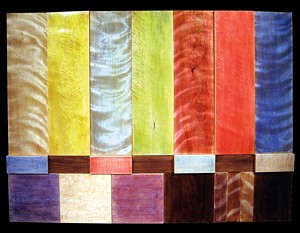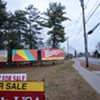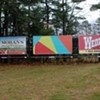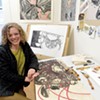Published February 20, 2013 at 10:44 a.m. | Updated December 3, 2019 at 4:51 p.m.
Hanging against the white walls of the SEABA Gallery on Pine Street in Burlington, Robert Hitzig’s geometric wooden sculptures glow with a subtle sheen. Up close, the layers of tinted shellac magnify the natural grain of the wood. Viewers may have an urge to run a hand across their surfaces, just to see if the pale color hides any imperfections. But, tempting as it may be, don’t ask Hitzig what his floor-laying schedule is. These days, his oeuvre is form, not function.
“I get plenty of requests about doing floors for people when they see my work — and I always have to say no,” Hitzig says with a slight grin. “I like to take wood into the fine-art realm and make it look like art, rather than furniture or something functional.”
That hasn’t always been the case. Working first as an agroforester for the Peace Corps and then for 10 years with the Environmental Protection Agency, Hitzig spent years thinking about forests and timber in a practical way. He indulged in a furniture-making hobby for a while. And then, in 2007, he got tired of function.
“I liked to make furniture, but what I really loved was working with wood and exposing its natural beauty,” Hitzig says. “I was always thinking of how to turn the wood into art, rather than actually making something that served a purpose. And finally I decided that, if I really wanted to do that, I needed my own workshop and my own tools.”
So Hitzig moved from Washington, D.C., to Vermont. He and his then-wife, Mary Jo Krolewski, opened the Lazy Pear Gallery in an old Victorian house in Montpelier. Hitzig soon decided he wanted to be a full-time artist.
He began carving whimsical shapes and creatures out of wood and finishing them with a shellacking technique developed by French furniture makers in the 1820s, Hitzig explains. He became intrigued by the highly polished, intensely clear finish he could generate with a ball of cloth, shellac, alcohol and a little oil rubbed repeatedly over the wood’s surface.
The 15 or so wall-hung wood pieces on display in the SEABA Gallery lack the lightheartedness of Hitzig’s earlier creations. Though he takes care to make interesting shapes, the real artfulness here is in his enhancement of the wood’s natural beauty. He doesn’t stain the wood itself, but layers clear shellac thickly on top. That creates a canvas that seems to float above the wood, giving Hitzig a surface on which to paint with his hand-mixed, tinted shellac. The layers yield a soft wash of color that allows the grain of the wood to show through, played up by the showiness of Hitzig’s preferred trees: curly maple, bird’s-eye maple and birch.
Peering closely at the grain in a rectangular work titled “The Revolution Will Not Be Televised” — and tinted in the color sequence of the old TV test pattern — Hitzig notes that he’s particularly drawn to the larger, freer curves evident in birch wood.
“Because of the natural movement in the grain, it almost has a fabric look to it,” he says. “It’s perfect for my flag series.”
Referencing Jasper Johns’ neo-Dadaist take on the American flag in the 1950s, Hitzig’s flag series similarly attempts to divorce the artwork from its patriotic symbolism, redefining it in a purely aesthetic sense. But his lustrous and meticulously joined pieces of wood are hardly blank. The striations in the wood’s grain make the surface appear to ripple. Hitzig hopes at some point to exhibit his flag sculptures as a series. Meanwhile, the geometry and stripes of his other works more clearly reference painter/printmakers Frank Stella and Sean Scully.
If Hitzig’s earlier works relied on the character of the wood to draw out a figure or character, this recent body of work seems to reverse the process.
“In furniture, you spend a lot of time creating the design, so you can’t spend a lot of time on the finish,” Hitzig says. “This is really an inversion of the furniture-making process. I see the wood as a canvas, so the art is painting, not sculpture.”
Hitzig started moving away from standard geometric shapes after attending a talk by Frank Stella in conjunction with that artist’s 2010 exhibition at the Hood Museum of Art at Dartmouth College. In a Q&A, Stella mentioned the moment when he “broke free of the tyranny of the rectangle,” and Hitzig was motivated to do the same.
More abstract forms followed that revelation, such as the seven-sided “A Tear of Joy and Profound Admiration,” an angular, striped work, and “What Is?” one of the few works painted a single, solid color. Hitzig refers to the color as “black,” but the polished maple reflects colors from yellow-green to dark purple. While he still rejects the thought of turning his meticulously created paintings into functional art (or floorboards), Hitzig admits he’s turning toward more austere woods and colors.
“I’m more and more drawn to ash, and figure that’s the direction I want to go,” he says. “The curly maple and the birch have a figure that’s just too easy to make beautiful. By using something plainer and more austere, I can create more of a canvas for my work.”
The print version of this article was headlined "Into the Woods".
More By This Author
Speaking of Art, eyewitness
-

Q&A: Catching Up With the Champlain Valley Quilt Guild
Apr 10, 2024 -

Video: The Champlain Valley Quilt Guild Prepares for Its Biennial Quilt Show
Apr 4, 2024 -

Q&A: Meet a Family in Waterbury That Embraces Halloween Year-Round
Feb 14, 2024 -

Video: Goth Family in Waterbury: Sarah, Jay and Zarek Vogelsang-Card
Feb 8, 2024 -

Q&A: Art Entrepreneurs Tessa and Torrey Valyou Celebrate 15 Years of New Duds
Oct 11, 2023 - More »
Comments
Comments are closed.
From 2014-2020, Seven Days allowed readers to comment on all stories posted on our website. While we've appreciated the suggestions and insights, right now Seven Days is prioritizing our core mission — producing high-quality, responsible local journalism — over moderating online debates between readers.
To criticize, correct or praise our reporting, please send us a letter to the editor or send us a tip. We’ll check it out and report the results.
Online comments may return when we have better tech tools for managing them. Thanks for reading.

















































